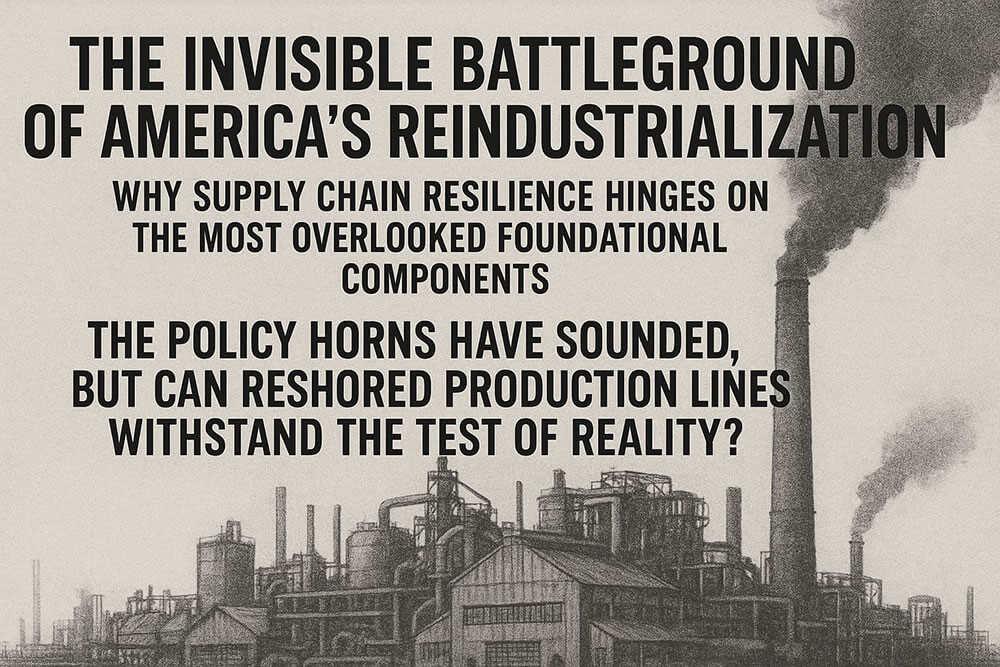Rethinking Industrial Resilience: The Unseen Backbone of Modern Manufacturing #

The Policy Shift: Can Reshored Production Lines Meet Real-World Demands? #
A powerful wave of “reindustrialization” is sweeping across North America, driven by the “Made in America” initiative. This movement is more than a policy slogan—it’s a strategic transformation of global supply chains, aiming to address vulnerabilities exposed over recent years. Industries such as automotive, steel, and heavy machinery are rapidly bringing production back onshore. However, this resurgence is not about replicating outdated processes; it’s about embracing a new era of automation and resilience.
Automation is now essential, especially as labor structures evolve globally. Yet, the challenge lies in adapting “laboratory-grade” automation—originally designed for controlled environments in electronics manufacturing—to the demanding realities of traditional industries. These environments are characterized by dust, high temperatures, impacts, and chemical exposure. The direct transplantation of standard automation solutions often fails, and the breakdown of a single foundational component can disrupt entire production lines, leading to hidden costs that far exceed initial expectations.
The Hidden Costs of Upgrading Factory Automation #
For manufacturers seeking to modernize, the greatest risks are not always in upfront investments, but in the operational losses that stem from inadequate environmental adaptability. Standard motion components often struggle in traditional factory settings, leading to three major hidden costs:
-
Environmental Erosion:
- Steel mills and automotive plants expose components to abrasive dust, sparks, and cutting fluids, which can quickly compromise standard seals. Once breached, contamination leads to bearing failure, resulting in costly production shutdowns and delayed orders.
-
Wear and Tear from Extreme Conditions:
- High temperatures can degrade standard lubricants, while cold environments cause them to solidify. Repeated impacts from heavy machinery accelerate asset depreciation and increase unplanned maintenance and labor costs.
-
Unreliability and Cascading Failures:
- In interconnected automated lines, the failure of a single support unit can misalign robotic arms, damaging valuable equipment and workpieces. These cascading failures reduce Overall Equipment Effectiveness (OEE) and are difficult to quantify financially. Opting for merely “adequate” components introduces significant long-term risks.
Building a Moat: Turning Durability into Productivity with SYK Solutions #
Selecting foundational components is now a matter of risk management and operational strategy. SYK’s heavy-duty WBK, SBK, and MBK series support units are engineered to transform extreme durability into stable, predictable productivity.
1. Structural Strength: Mitigating Operational Risks #
- P4 grade angular contact TAC ball bearings are at the core, designed to withstand harsh conditions and absorb significant axial impact forces. This ensures precision and longevity in high-speed, heavy-load applications, reducing downtime from fatigue failures.
2. Advanced Sealing: Shielding Against Environmental Threats #
- Multi-layered defense systems with reinforced oil seals and dust caps create a robust barrier, protecting not just the bearings but the continuity of business operations. This extends maintenance intervals and reduces the likelihood of unexpected failures.
3. Material Science: Consistent Performance in Any Environment #
- Customized low outgassing and low-temperature grease solutions provide broad operational adaptability. Whether in cleanrooms or freezing warehouses, SYK components maintain reliable lubrication, ensuring consistent returns on automation investments.
Editor’s Perspective: Risk Factors and Strategic Countermeasures #
| Operational Risk Factor | Impact on Finances | SYK’s Strategic Value |
|---|---|---|
| Environmental Contaminant Erosion | Downtime, repair costs, production bottlenecks | Reinforced Sealing System: Extends asset life, maximizes uptime |
| High Impact & Vibration Loads | Precision loss, cascading failures | Heavy-Duty TAC Bearings: Secures long-term reliability |
| Extreme Temperature Variations | Unstable performance, unplanned failures | Customized Lubrication: Expands stable operating window |
| Supply Chain Uncertainty | Spare part delays, production halts | Vertically Integrated Production: Enhances supply resilience |
Frequently Asked Questions (FAQ) #
Q1: What distinguishes TAC angular contact ball bearings from general angular contact bearings from an investment perspective?
A1: General angular contact bearings are cost-effective but designed for mass-market use, offering limited precision and lifespan. TAC bearings, however, are engineered for high-precision ball screw support, providing superior axial force capacity, rigidity, and longevity. While the initial investment is higher, TAC bearings reduce long-term maintenance costs and enhance equipment reliability and brand value, making them a sound long-term investment.
Q2: Can SYK offer holistic strategic advice for extremely harsh environments beyond component protection?
A2: Yes. SYK provides not only products but also application reliability consulting, including customized grease solutions to minimize failure risks and help clients build robust production systems.
Q3: How can I justify a higher initial cost for foundational components to the board?
A3: Present a risk assessment based on Total Cost of Ownership (TCO). While SYK’s WBK, SBK, and MBK series require a higher upfront investment, they significantly reduce unplanned maintenance and downtime costs over time. This approach shifts spending from reactive repairs to preventive investment, offering greater long-term financial returns.
Q4: What is the biggest operational risk when installing a long-stroke, heavy-duty system?
A4: The primary risk is permanent loss of precision due to misalignment. Ensuring coaxiality during installation is critical, as misalignment introduces internal stress and accelerates depreciation from the outset.
Q5: What is the strategic value of SYK’s vertically integrated production for supply chain agility?
A5: Vertically integrated production reduces supply chain complexity and uncertainty, especially amid geopolitical risks. Fewer subcontractors mean fewer potential disruptions. SYK’s model ensures fast delivery, reliable supply, and greater flexibility, providing a competitive edge.
Conclusion: Strategic Components for a Resilient Industrial Future #
The revival of American manufacturing is a story of national competitiveness, but its success depends on attention to every operational detail. Factories built for both efficiency and resilience require components that can withstand the challenges of the coming decades. For high-precision CNC machines, PCB processing, and other demanding applications, choosing SYK’s heavy-duty WBK, SBK, and MBK series is more than procurement—it’s an investment in uptime, operational resilience, and long-term profitability.
Is your automation investment ready for the future?
Schedule a one-on-one Operational Resilience Consultation with our engineering team to explore robust motion solutions for harsh industrial environments. Let’s build a legacy of industrial excellence together.